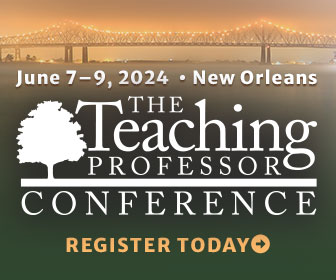As a follow-up to
last week’s post, here’s a final bit from my rummaging around old favorites in my personal library of teaching and learning resources.

The insights come from Roy Starling’s great piece in which he recounts his experiences of being released from his teaching responsibilities to take a full load of courses with a small group of undergraduates. It radically changed his teaching, as it did Marshall Gregory’s when he enrolled in an undergraduate acting class, and as it did mine when I took a non-major’s chemistry course with 20 first-semester students. Most faculty do not have time to take courses or they’re at institutions without programs that support these experiences. However, even short visits to a colleague’s class and experiencing it as a student (not a peer reviewer) yields insights about teaching and motivates change.
Most teachers start courses pretty much the same way—introduce the content, go over the course requirements, talk about grades, and spell out various policies. Starling was surprised by how confusing, indeed disorienting, he found this. Every course had its own set of details and requirements that students are supposed to immediately understand and follow. He and his fellow classmates (they all took the same four courses) quickly moved from learning to survival mode.
Based on that experience, here are four things Starling resolved to change once he returned to teaching.
- Use group work on the first day and use it as a way to get students introduced to the content and each other. If teachers want participation in their courses, students must be encouraged to do so starting on the first day. The introduction of course content is important because then students “are more likely to leave this first class pondering ideas than dreading assignments.” (Starling, p. 4)
- Spend more time talking about the rationale behind assignments. Too often the emphasis is on clarifying what students are supposed to do, rather than why they are being asked to do it. Starling notes that without understanding the rationale behind assignments, his classmates ended up considering most of their assignments pointless busy work. If that’s how students orient toward assignments, it certainly dampens their motivation to devote the time and energy needed to do good work.
- “I will assign no superfluous material.” (Starling, p. 4) As a nurse educator said to me recently, “I’ve come to accept that there is content my students need to know and content that is nice to know. They’ll get to the nice-to-know stuff when it becomes a need to know, given what they end up doing.” Gregory (2005) makes the point this way, “Teachers who love specific kinds of content often misrepresent the kind of usefulness that content will have for most of their students. Mostly, students do not get educated because they study our beloved content. They get educated because they learn how to study our beloved content, and they carry the how of that learning with them in the world as cognitive and intellectual skills that stick long after the content is forgotten.” (p. 97) There are external expectations about what needs to be covered in a course and those cannot be ignored, but what made chemistry difficult for me was not the content per se, but how much of it there was and how fast it came.
- “Knowing now that student gripes are often legitimate, I will complain less about complaining students. … I will now be more sympathetic, more flexible, preferring to be taken in by several students than to push one over the edge.” (Starling, p. 4)
One of the best parts of the Starling article is a collection of excerpts written before, during, and after the first exam. “The pre-exam tension headache and nervous stomach of yesteryear showed up like unexpected in-laws. I try to ease out of my role and make the exam not matter. . . . Doesn’t help, the exam still matters. I study too late then dream that exam day is here and I haven’t studied at all.” (p. 5) I remember confidently telling my chemistry classmates that we were so well prepared for the first quiz, a lot of us were going to ace it. That’s what I believed, but my 6/10 score was the average.
Two take-aways: I would almost guarantee that if you struggle to learn something in a course other than your own, it will change how you teach; and 20 years at the front of the room (maybe less) erases virtually all memories of what it’s like to be seated in a small, uncomfortable desk somewhere in the middle of the room.
References: Starling, R., (1987). Professor as student: The view from the other side.
College Teaching, 35 (1), 3-7.
Gregory, M., (2005). Turning water into wine: Giving remote texts full flavor for the audience of
Friends.
College Teaching, 53 (3), 95-98.
Gregory, M., (2006). From Shakespeare on the page to Shakespeare on the stage: What I learned about teaching in acting class.
Pedagogy, 6 (2),309-325.
© Magna Publications. All rights reserved.














 The insights come from Roy Starling’s great piece in which he recounts his experiences of being released from his teaching responsibilities to take a full load of courses with a small group of undergraduates. It radically changed his teaching, as it did Marshall Gregory’s when he enrolled in an undergraduate acting class, and as it did mine when I took a non-major’s chemistry course with 20 first-semester students. Most faculty do not have time to take courses or they’re at institutions without programs that support these experiences. However, even short visits to a colleague’s class and experiencing it as a student (not a peer reviewer) yields insights about teaching and motivates change.
Most teachers start courses pretty much the same way—introduce the content, go over the course requirements, talk about grades, and spell out various policies. Starling was surprised by how confusing, indeed disorienting, he found this. Every course had its own set of details and requirements that students are supposed to immediately understand and follow. He and his fellow classmates (they all took the same four courses) quickly moved from learning to survival mode.
Based on that experience, here are four things Starling resolved to change once he returned to teaching.
The insights come from Roy Starling’s great piece in which he recounts his experiences of being released from his teaching responsibilities to take a full load of courses with a small group of undergraduates. It radically changed his teaching, as it did Marshall Gregory’s when he enrolled in an undergraduate acting class, and as it did mine when I took a non-major’s chemistry course with 20 first-semester students. Most faculty do not have time to take courses or they’re at institutions without programs that support these experiences. However, even short visits to a colleague’s class and experiencing it as a student (not a peer reviewer) yields insights about teaching and motivates change.
Most teachers start courses pretty much the same way—introduce the content, go over the course requirements, talk about grades, and spell out various policies. Starling was surprised by how confusing, indeed disorienting, he found this. Every course had its own set of details and requirements that students are supposed to immediately understand and follow. He and his fellow classmates (they all took the same four courses) quickly moved from learning to survival mode.
Based on that experience, here are four things Starling resolved to change once he returned to teaching.